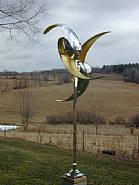Albany NY Monthly Heating Degree Days Data
This table shows monthly heating degree days for the Albany NY area from January 2000 through June 2008. The term heating degree days is defined below.
NOTE Now that I've retired and travel full time in my RV (My Lazy Daze) and no longer spend winters in NY I'm discontinuing the updating of this table. The data this table is based on is available at the National Weather Service Climate Prediction Center Degree Days Statistics website.
For several years I've been collecting heating degree day information for the Albany, NY area (the closest data I found to the Chatham area where I live) and tabulating the trends monthly and as a 12 month moving average to get a feel for how much my heating fuel needs vary from season to season and how far above or below normal the current usage might be.
| 2008 | 2007 | 2006 | 2005 | 2004 | 2003 | 2002 | 2001 | 2000 | Normal | |
| January | 1156 | 1160 | 1031 | 1404 | 1561 | 1512 | 1036 | 1246 | 1368 | 1257 |
| February | 1114 | 1275 | 1040 | 1061 | 1162 | 1262 | 927 | 1060 | 1077 | 1070 |
| March | 955 | 1027 | 895 | 1049 | 839 | 950 | 885 | 1048 | 762 | 889 |
| April | 394 | 622 | 462 | 440 | 486 | 612 | 511 | 522 | 585 | 528 |
| May | 300 | 196 | 232 | 325 | 154 | 253 | 326 | 202 | 209 | 220 |
| June | 17 | 40 | 43 | 6 | 54 | 46 | 51 | 46 | 74 | 42 |
| July | 7 | 0 | 0 | 3 | 0 | 4 | 21 | 14 | 4 | |
| August | 25 | 17 | 1 | 25 | 9 | 9 | 0 | 25 | 13 | |
| September | 86 | 130 | 58 | 79 | 91 | 69 | 116 | 207 | 124 | |
| October | 271 | 500 | 410 | 464 | 519 | 538 | 407 | 456 | 463 | |
| November | 816 | 608 | 674 | 764 | 677 | 790 | 607 | 801 | 741 | |
| December | 1146 | 918 | 1179 | 1157 | 1103 | 1177 | 954 | 1323 | 1085 | |
| TOTAL | 6671 | 5876 | 6607 | 6748 | 7034 | 6323 | 6219 | 6901 | 6438 |
| Heating Season | Total |
| 2000-2001 | 6950 |
| 2001-2002 | 5841 |
| 2002-2003 | 7222 |
| 2003-2004 | 6655 |
| 2004-2005 | 6777 |
| 2005-2006 | 6025 |
| 2006-2007 | 6493 |
| 2007-2008 | 6287 |
| Normal | 6438 |
Note: Normal is a 30-year degree day average value for the period 1971-2000.
Source: National Weather Service Climate Prediction Center Degree Days Statistics
Albany NY Heating Degree Days 12 month moving average shows the data above charted as a 12 month moving average.
Heating degree days
Heating degree days is a way to keep track of the relative amount of energy needed to heating a building (or buildings). The cooler the weather, the larger the number of heating degree days... and the larger the number of heating degree days, the larger the amount of energy needed to heat a building (or buildings).
How heating degree days are calculated
The number of heating degree days for any particular day is the average temperature for the day subtracted from a base value of 65 degrees F. The average temperature for the day is calculated by adding the high temperature for the day to the low temperature for the day and dividing the sum by 2.
